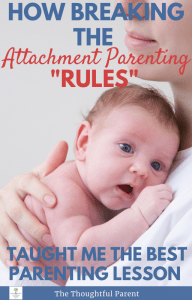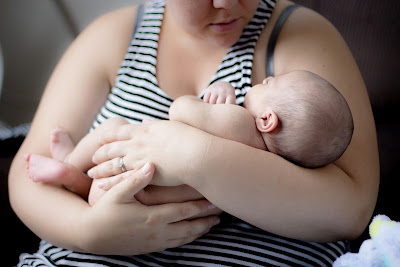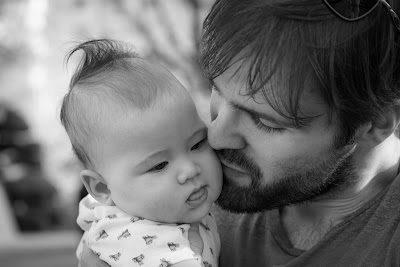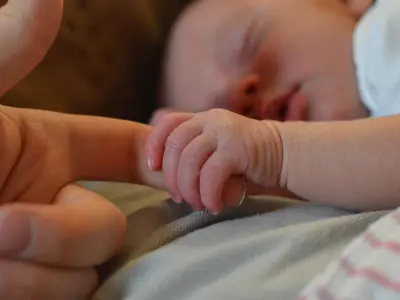Sneak peek: What is attachment parenting and how does it differ from attachment theory? A new outlook on parenting emerged as I learned the difference.
I clearly remember sitting in my first mom’s group 7 years ago. It was summer in Texas so I was sweating from carrying my son in his car seat into the meeting. I was also sweating because I was nervous. I had heard from my lactation consultant that groups like this talked a lot about attachment parenting, nursing tips and everything about new babies. But I wasn’t sure what to expect but I wanted to learn anything I could about child development and parenting.
Would my son cry the whole meeting? Did I bring the nursing cover?
I sat down and yes, he immediately started crying. I took him out of the car seat and tried to console him quickly so we wouldn’t make a scene.
All the other moms seemed so much more relaxed. I seemed to be the only one with a newborn. This was one of the first times I had taken him out of the house by myself so I was just getting used to the whole procedure–car seat, diaper bag, etc.

Soon I heard the other moms discussing things like babywearing, co-sleeping, and attachment parenting. My mind was swimming. I have a degree in human development, but I was confused. What is attachment parenting compared to the attachment theory I had learned about in grad school?
In my graduate classes, there was no discussion of specific parenting “principles” that made up attachment theory. I just remember it being about trying to be as responsive to your child as possible. Hmm…I’m going to have to look into to this.
Related reading: A Parent’s Guide to Understanding the 4 Attachment Styles
I remained listening to the rest of the meeting and became more intimidated. I loved my son dearly, but I didn’t really want him in bed with me until he was a toddler. That’s what seemed to be the norm among these moms. Is that how I need to parent to form a secure attachment with him?
I went home almost in tears and confused. I never returned to that group.

What is Attachment Parenting?
Fast forward a few years and I now have a much better understanding of the differences between attachment parenting and attachment theory.
I have written about the distinction between attachment theory and attachment parenting several times, but it is a topic I feel is worth revisiting. The word “attachment” is thrown around in modern parenting circles often, but there is a lot of confusion about what it really entails.
Related reading: The Long Reach of a Baby’s Temperament
This attachment parenting article and guide to attachment theory explains in-depth the research behind attachment theory. In essence, attachment between parent and child is about the relationship that is formed in the early months and years between a baby and her primary caregiver. The beautiful thing about attachment theory is that it does not prescribe a set of specific parenting techniques or principles per se. At its core, it is a concept that helps explain the subtle, back-and-forth, dynamic relationship that happens between a baby and a truly responsive parent.
Responsiveness means learning to read your baby’s unique signals; not a preconceived notion of what a baby needs. All babies have basic needs for closeness, care, feeding, etc. But how your baby expresses each need is unique. Some babies like being worn in a carrier, some like the swaying motion of a swing. Some babies need quiet to sleep well, others can sleep in a noisy room.
In real life, that means that attachment between myself and my child might look a little different than attachment between you and your child. It can even mean that attachment between you and each of your own children might look a little different.
 This post contains affiliate links. Purchasing through these links helps support this blog at no added cost to you.
This post contains affiliate links. Purchasing through these links helps support this blog at no added cost to you.
Parenting for Secure Attachment (not just following the rules)
A Tale of Two Attachments
As you can see, attachment parenting seems to involve a set of “rules” or principles like co-sleeping, babywearing, and extended breastfeeding. While all those practices are great, they alone do not ensure a secure attachment. According to the science of attachment theory, it’s the relationship between the baby and caregiver that determines the type of attachment. Thus, a secure attachment with two different children might look slightly different.
For example, my first son was a snuggler. He loved being worn in a baby carrier, loved laying on my chest, etc. So that’s what my husband and I did…all the time. He responded well to this and gradually over time was able to sleep in his crib.
We assumed that our second son would be much the same way–I mean what baby doesn’t love snuggles. Well, he was a bit different. Of course, all babies love being close to their parents, but as soon as he could lift his head and squirm just a bit, he pretty much tried to wiggle out of our arms. He occasionally slept on us, but really preferred the swing. He still liked being close to us but needed a bit more space.
Now, does one of my sons have a more secure attachment to us than the other? We have never done the “official” attachment test (there is a laboratory procedure to assess this) but based on their self-regulation and interaction with others, I feel fairly confident that they both have a secure attachment to us.
Attachment Theory Research
I do not claim that I have always done everything perfectly in terms of attachment-forming with my kids. But here’s the wonderful thing about attachment--it allows room for mistakes and correction. Maybe you misread your baby’s signal…she will probably let you know in some way and you can try again. Maybe you were distracted or upset one day and could not be as responsive as you would normally be–you can make up for it the next day. It’s the predominant pattern of interaction that really makes up attachment. Does your child feel you can be relied upon most of the time for help, care, and assistance with their needs and emotions?
Attachment is really about guiding your child through emotional regulation. As Diana Divecha describes in her article, “parenting for a secure attachment… is not a prescriptive set of behaviors but more a state of mind, a way of ‘being with’ the baby, a sensitivity to what they are feeling.”
Giving Up the Attachment Parenting “Rules”
With this in mind, I’ve ditched the culturally derived “rules” (for attachment and otherwise) and have instead tried to focus on the relationship with my kids. I simply try my best to meet my kids where they are at in a particular phase of development.
- I included formula in my son’s diet (along with breastfeeding) even though “the rules” said it was not recommended. I needed enough sleep to be responsive to my son rather than emotionally checked out.
- I allowed my son to have a pacifier until he was 2.5 years old–another thing “the rules” did not support. I decided I would rather play with him than battle him over a piece of silly plastic. Note: he ended up throwing it the trash on his own.
- Both my boys were not completely potty-trained until they were almost 4 years old (much to my chagrin). Ultimately, I had to value our relationship over “the rules” of an arbitrary timeline. Plus, you can lead a toddler to potty, but…(you know the rest).
This is where “rules” fall apart–there are no rules for the dynamic, ever-changing relationship with your kids.
The key idea that attachment theory has taught me in a broader sense is that parenting is more about relationships than rules. If I can keep this in mind, things usually fall into place.
“Life is best organized as a series of daring ventures from a secure base.” –John Bowlby (co-founder of attachment theory)
More Resources on Attachment Theory:
The Thoughtful Parent posts on Attachment Theory: part 1 and part 2
Diana Divecha’s wonderful article: What is Secure Attachment? And Why Doesn’t “Attachment Parenting” Get You There?
Another excellent article: Can Attachment Theory Explain All Our Relationships?









Leave a Reply